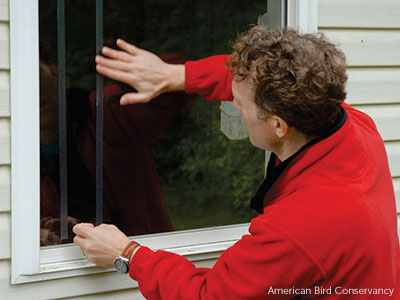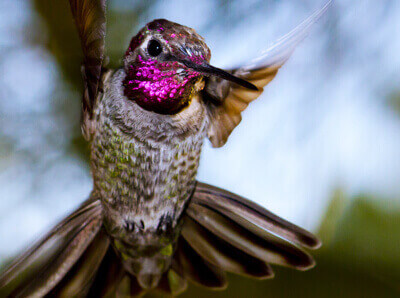Multiple interacting factors influence the collision threat that a given building poses to birds (Hager, 2008; Hager et al., 2013). Klem et al. (2009), looked at architectural and landscape variables for 73 buildings in New York City and concluded that the amount of glass on a façade was the best predictor of mortality, with every 10% increase in glass area having an increase in collisions of 19% or more (depending on season). Cusa et al. (2015) also found a strong relationship between amount of glass and number of collisions on buildings in Toronto.
In a large, thorough analysis of data from window collision monitoring programs and other sources, Loss et al. (2014) estimated overall annual window collision mortality to be between 365 and 988 (median 599) million birds killed annually in the United States. ABC believes that the true number is closer to 1 billion birds killed by glass every year. This is for several reasons: The data in the Loss et al. study are all from before 2014 and a great deal of glass has entered the built environment since then; we have since learned that monitors miss a much higher percentage of bird carcasses than had been assumed; and the study did not include an estimate of birds that survived the initial collision but later died as a result of injuries sustained during the collision, a number that is likely significant, but which has not yet been well estimated.
In Loss's study, different types of structures were associated with different rates of mortality, with a median mortality rate of 2.1 birds per home (1-3 stories), 21.7 birds per structure for low-rise buildings (4-11 stories), and the highest median rate of 24.3 bird collisions per building for high rises (12+ stories). The increase in collision rates from low rise to high rise is small – presumably because most collisions on high-rise structures occur on the lower floors.
To create policy, it would be useful to have more data on the amount of glass on each structure in the dataset, or to be able to translate collisions per building into collisions per some unit of building measurement (e.g., footprint or façade area). Unfortunately, these data are not available. Comparing the rates for low-rise and high-rise buildings indicates that floors above the 12th story may contribute relatively little to overall mortality.
Looking for glass for a new building, or a solution to fix existing windows? Search our comprehensive material database to find the right product.
It is difficult for collision monitors to know precisely where on a façade a collision occurred because they are picking up dead birds on the ground . Birds may also bounce or fly away without leaving a mark (Klem, 2009). However, monitors able to view setbacks and roofs report bird carcasses that would not be tallied by more typical monitors restricted to ground level. Collisions on higher levels of buildings may thus be underestimated. However, a large, multi-site study by Hager et al. (2017) also called out low-rise buildings, especially those in vegetated suburban areas like office parks.
The habitat immediately surrounding buildings draws birds into close proximity with glass. This nearby vegetation and reflections in the glass bear directly on the likelihood of collisions. Birds are also attracted to areas with water, both during the day and by lights, as they end migration stages at night (Bonter et al., 2008), so buildings near aquatic habitats like stream banks, lakesides, and marshes may experience greater numbers of collisions. However, because these areas attract birds that may have to travel through the built environment to get there, and because birds often make use of small areas of vegetation, studies show even mid-city buildings can cause large numbers of collisions.
Studies have repeatedly found that glass that reflects vegetation, up to treetop height, is more likely to cause collisions (Gelb and Delacretaz, 2009; Gelb and Delacretaz, 2006; Klem et al., 2009; Kummer et al., 2016; Liu and Yanchun, 2017). Agudelo-Alvarez et al. reported that situations where vegetation was seen through glass caused more collisions than simple reflection, perhaps because much reflective glass can vary significantly in reflectivity throughout the day.
Buildings that reflect vegetation are an issue but it is more complex than that – vegetation is a proxy for the activity zone of birds because birds spend the majority of their time where resources like food, shelter, and perching and roosting sites are available. Birds may also want to fly over vegetation through reflected sky, or around a structure, in landscape reflected in glass. Different heights above the ground have been used in legislation and guidelines as proxy for the zone where birds are most active, including 40 feet (LEED Credit SSpc55), 60 feet (see San Francisco and Toronto standards), and 75 feet (New York City).

Are birds colliding with your home or building? Use our guide to find solutions and protect birds!
Agudelo-Álvarez, Laura, Johan Moreno-Velasquez & Natalia Ocampo- Peñuela, 2010. Colisiones De Aves Contra Ventanales En Un Campus Universitario De Bogotá, Colombia (Collisions of birds with windows on a university campus in Bogotá, Colombia). Ornitología Colombiana No. 10 (2010): 3-10.
Bonter, David N., Sidney A. Gauthreaux Jr., And Therese M. Donovan, 2008. Characteristics of Important Stopover Locations for Migrating Birds: Remote Sensing with Radar in the Great Lakes Basin. Conservation Biology, Volume 23, No. 2, 440–448. DOI: 10.1111/j.1523-1739.2008.01085.
Cusa, Marine, Donald A. Jackson and Michael Mesure, 2015. Window collisions by migratory bird species: urban geographical patterns and habitat associations. Urban Ecosystems doi:10.1007/s11252-015-0459-3)
Gelb, Y. and N. Delacretaz, 2009. Windows and Vegetation: Primary Factors in Manhattan Bird Collisions. Northeastern Naturalist 6(3):455–470.
Gelb, Y. and N. Delacretaz. 2006. Avian window strike mortality at an urban office building. Kingbird 56(3):190-198.
Hager, S.B., H. Trudell, K.J. McKay, S.M. Crandall, L. Mayer. 2008. Bird density and mortality at windows. Wilson Journal of Ornithology 120(3):550-564.
Hager SB, Cosentino BJ, McKay KJ, Monson C, Zuurdeeg W, and B. Blevins, 2013. Window Area and Development Drive Spatial Variation in Bird- Window Collisions in an Urban Landscape. PLoS ONE 8(1): e53371. doi:10.1371/journal.pone.0053371 http://people.hws.edu/cosentino/publications_files/PLoS%20ONE%20201 3%20Hager.pdf
Hager, Steven B. et al., 2017. Continent-wide analysis of how urbanization affects bird-window collision mortality in North America. Biological Conservation 212: 209-215 http://dx.doi.org/10.1016/j.biocon.2017.06.014
Klem, D. Jr., C. J. Farmer, N. Delacretaz, Y. Gelb and P.G. Saenger, 2009. Architectural and Landscape Risk Factors Associated with Bird-Glass Collisions in an Urban Environment. Wilson Journal of Ornithology 121(1): 126-134.
Kummer, Justine A., Erin M. Bayne and Craig S. Machtans, 2016a. Use of citizen science to identify factors affecting bird–window collision risk at houses. The Condor, 118(3):624-639. DOI: http://dx.doi.org/10.1650/CONDOR-16-26.1 URL: http://www.bioone.org/doi/full/10.
Liu, Hui and Xu Yanchun, 2017. Bird Collision with Building Glass Outer Wall Caused by Landscape Structure: a Case Study; College of Wildlife Resources, Northeast Forestry University; Chinese Journal of Wildlife, 2014-02
Loss, Scott R., Tom Will, Sara S. Loss and Peter P. Marra, 2014. Bird–building collisions in the United States: Estimates of annual mortality and species vulnerability. The Condor 116:8-23. DOI: 10.1650/CONDOR-13- 090.1
Birds, unlike humans, are unable to understand or learn the concept of ‘glass' as an invisible barrier that can also be a mirror. Birds take what they see literally – and glass can appear to be habitat they can fly into, whether the habitat is reflected, or seen through a pane of glass.

Visit our photo gallery to see how a variety of materials and techniques can be used to make buildings safe for birds and great for people.
Check out BirdCalls Blog for frequent updates and insights into birds and window collisions…. Read more >>